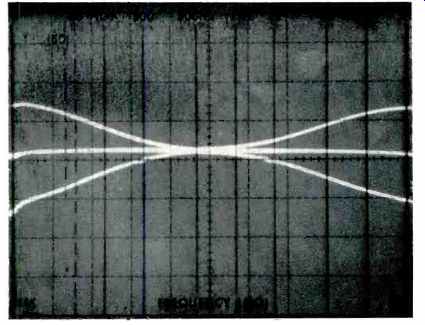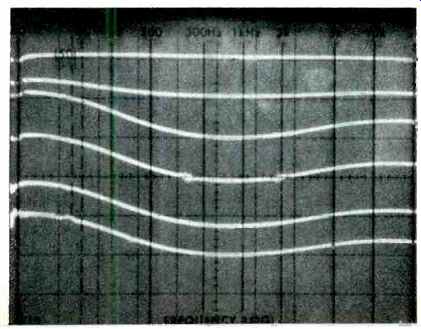Philips High Fidelity Laboratories introduced a complete line of high-fidelity component products nearly a year ago, and that in itself is quite an accomplishment when you consider the fact that initially introduced products included a tuner, a separate preamplifier (the subject of this report), and a basic power amplifier--all these in addition to their previously introduced turntable systems and motional feedback speakers. For those who aren't aware of recent corporate changes in the Philips setup, it should be noted that Philips High Fidelity Laboratories was organized as a independent company, part of Magnavox Electronics Company in January 1976. Magnavox, in turn, is totally owned by the North American Philips Co., which suggests that the Philips Laboratory line can avail itself of all the technical know-how of the giant Philips company of the Netherlands, a highly reputed, international electronics organization.

- - -
MANUFACTURER'S SPECIFICATIONS:
Rated Output: 2.0 volts.
Maximum Output:12 volts.
Phono Input Sensitivity: 1.5 to 18 mV.
High Level Input Sensitivity: 200 mV.
THD (At Rated Output): 0.01 percent.
IMD (At Rated Output): 0.01 percent.
Phono Overload: 750 mV.
Frequency Response: Phono, RIAA +0,-0.5 dB; High Level, 10 Hz to 45 kHz-1.0 dB.
S/N Ratio: Phono, 75 dB, "A" Weighting, re: 1.5 mV in.; High Level, 90 dB, "A" Weighting.
Bass Control Range: ±10 dB @ 50 Hz.
Treble Control Range: ±10 dB @10 kHz.
High Cut Filter: -9 dB @ 10 kHz.
Low Cut Filter: -9 dB @ 50 Hz.
Audio Muting: -20 dB.
General Specifications
Power Requirements: 120 V, 50/60 Hz, 22 watts.
Dimensions: 18 in. (45.7 cm) W x 5 1/2 in. (14 cm) D x 13 1/2 in. (34.3 cm).
Weight: 22 lbs. (10 kg).
Price: $599.95.
- - -


Certainly, from the looks of the front panel of the AH-572, this is not a "me-too" design. The entire upper left section of the panel is devoted to an illuminated graphic representation of the "block diagram" or signal-flow chart of the circuitry inside. Selected program source inputs, tape monitoring choices, listening mode, and even output selected (there are two output jack sets) are indicated in an easy-to-understand illuminated signal-flow display. Next to this innovative graphic display is the four-position program selector switch (two phonos, tuner, and AUX), center-detented balance control, and a step-detented calibrated master volume control. The dB notations are in 2-dB steps all the way down to-34 dB, with greater dB increments from that point down to "infinite" attenuation.
The lower section of the panel is distinguished by a series of "hand capacitance" type, non-mechanical switches. The touch of a finger across the surface of these switches activates the switch and, at the same time, causes illumination of an LED light contained in each switch element. Switches of this type are used to turn on power, select either of two main outputs, defeat the tone control circuitry, activate low and high filters, the audio muting circuit, the loudness circuit, and tape monitoring. Conventional rotary switches, interspersed between the touch-switches, determine listening mode (stereo, reverse, Mono L+R, L only; or R only), and monitoring or dubbing from and to either of the two tape decks which may be connected to this preamplifier-control unit. Detent-step bass and treble controls are also located in this lower section of the panel, as are a headphone jack and tape-out/tape-in phone jacks which duplicate the second tape monitor circuit located on the rear panel.
In case you are wondering how an electronic touch-switch can be used to turn on power to the unit (since its action depends upon power being applied to the switch in the first place), the mystery is solved when you examine the rear panel. Here, we find a master power switch which must, of course, be turned on in order for the front panel touch-switch to do its job. With the master power switch activated, power is applied only to the circuits which are needed to make the front-panel power switch operative via a second, small transformer and auxiliary power supply. Other supply voltages to the preamp circuits proper are only turned on when the front-panel touch switch is activated. The arrangement is not unlike the "vacation switch" provided on some "instant picture" TV sets.
Below the twin sets of phono inputs on the rear panel are four individual input level controls, two for each set of phono input terminals. This arrangement is superior, even, to those which provide a single input level control for each phono input since having a separate control for left and right phono channels permits the user to precisely balance the stereo phono channels to compensate for even the most minute channel unbalance present in the phono cartridge with which the preamp is used. The rest of the rear panel is taken up by the required high-level input and tape-out jacks, the aforementioned dual sets of output jacks, a pair of chassis ground terminals, two switched and two unswitched a.c. receptacles, and a line fuseholder.

Fig. 1 Bass and treble control range of the Philips AH-572 Preamplifier.

Fig. 2 Highand low-cut filter range.
Circuit Highlights
There are several circuit features which distinguish this well-designed control center from many other preamp-control units. For one thing, each "tape play" input jack as well as each of the other high level inputs is followed by its own buffering emitter-follower stage. The low-impedance emitter output circuits of these individual stages helps insure against program cross-talk from unused program sources (tuner, for example), even if those connected program sources are delivering signals although not chosen by the program selector switch. Each phono preamp-equalizer circuit (for the Phono 1 and Phono 2 inputs) is separate, for a total of four completely independent five-transistor sections, each utilizing a differential-input pair of transistors. This admittedly more costly arrangement has the obvious advantage of not requiring any low-level switching (between Phono 1 and Phono 2 inputs), thereby reducing the possibility of hum and noise pickup. Besides the input/phono preamp circuit board modules, there are separate, well laid out p.c. boards for tape monitor/mode circuits, volume and filter circuits, tone control circuits, headphone and output amplifier circuits, power supply circuits, touch switch control circuits, and the touch switch module itself. The touch control module employs no less than eight Darlington-configured transistor packages, six ICs and eight bi-polar transistors, adding quite a bit of cost for this front panel elegance and signal-flow, illuminated display and the touch switches with their built-in LEDs are undoubtedly a significant addition to the cost of the bill-of materials of the AH-572 preamplifier.
If measured performance were anything but excellent on this unit, we would be inclined to say that Philips has, perhaps, sacrificed audible performance qualities in favor of front panel "gimmicks," but as it turns out, measured and audible performance were virtually beyond reproach, so we are inclined to forgive the makers of this preamp for having their "field day" with an unusual front panel design.
Laboratory Measurements
As calibrated by Philips, the Phono 1 and Phono 2 inputs were set for 1.9 mV and 10 mV input sensitivities, respectively. After checking the available range of input sensitivities using the four controls on the rear panel, we restored the settings to these levels and the rest of our phono measurements were based upon those input sensitivities.
Overload in phono (based upon 0.1 percent THD at 1 kHz) occurred with input signals of 180 mV and 870 mV for Phono 1 and Phono 2 respectively. Signal-to-noise ratio in phono was 74 dB and 83 dB, unweighted, and referred to the respective input sensitivity figures. Accuracy of RIAA equalization was an impressive ±0.1 dB from one end of the audio frequency range to the other. THD in phono measured 0.02 percent at 1 kHz, 0.015 percent at 500 Hz and 0.015 percent at 5 kHz, all for rated output (2.0 volts) at the main output terminals.
At rated output, with signals applied to the high level inputs, THD measured 0.01 percent, much of which was noise.
At 20 Hz, THD was 0.006 percent, while at 20 kHz, the reading for TE3D was 0.0055 percent. IM distortion measured 0.0035 percent for a 2.0 volt equivalent output. Overall clipping occurred at 14.0 volts output. Frequency response via the high-level inputs extended from below 10 Hz to 45 kHz, for the-1.0 dB roll-off points, and out to 54 kHz for a-3 dB reading. Hum and noise for the high level inputs measured 87.5 dB relative to a 2.0 volt output, unweighted.

Fig.
3 Loudness control characteristics.
The -3 dB cut-off points for the low- and high-cut filters occurred at 110 Hz and 4 kHz respectively-a bit too far within the important musical frequency range, in our opinion; both filters do employ a 12 dB/octave slope. Tone control range of the bass and treble controls is plotted in the 'scope photo of Fig. 1, while filter responses are shown in Fig. 2. Figure 3 illustrates the action of the loudness control circuits from 0 dB to -50 dB settings in 10 dB steps on the master volume control. These traces also serve to show the calibration accuracy of that control, since we set the control for different sweeps shown strictly on the basis of the stepped calibration marks surrounding that control of the front panel. (Each vertical division in the 'scope display represents an amplitude of 10 d B.) Eliminating the switching circuits at the phono inputs results in excellent channel separation, too, and we measured phono separation of 61 dB at 1 kHz and 43 dB at 10 kHz -- well beyond the capabilities of any phono cartridge we know of.
Use and Listening Tests
We must admit that even though we were keenly aware of the superfluity of those touch switches and signal-flow lights, we did enjoy using the former and observing the latter. So, too, will a great number of involved audiophiles who appreciate such graphic and easy-to-use extras. To our way of thinking, there is nothing wrong with adding a lot of control flexibility to a preamp control unit providing that those extras do not detract from overall sonic performance. In the case of the Philips AH-572, audio performance is excellent. Transient response in phono was especially free of edginess while bass and mid-range reproduction was full-bodied and completely transparent. Obviously, the designers of the AH-572 were concerned first with sound and we suspect that the rest of the frills were added later, more for their eye-appeal on the dealer's shelf than for any contribution they might make to the unit's audio reproduction capabilities. That's fine with us, for the moment. But we would hope that if and when Philips expands their introductory high fidelity component line, they might give thought to producing a similar preamp/control unit minus the lights and touch switches at considerably lower retail cost. More of us might then be able to afford this well-engineered product.
(Source: Audio magazine, Nov. 1977; Leonard Feldman)
Also see: Philips Model RH-532 Loudspeaker system (Apr. 1975)
Phase Linear Model 2000 Preamplifier (Sept. 1976)
= = = =